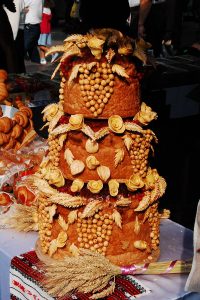
The festive table is an integral part of the Russian wedding. No other country can compare with the Russian customs of a wedding feast, despite the fact that large-scale feasts for this special day are arranged everywhere in the world. The menu of the Russian wedding is characterized by an abundance of national dishes. Nowadays, only a few people follow these traditions because they are complex and expensive to organize. But a wedding in the Russian style cannot do without a full-fledged Russian menu. One of the traditional dishes that must be present in a Russian wedding celebration is called Karavay.
The History of Russian Traditional Wedding Dishes
Dishes in Russian weddings were not just for refreshments. Each of them was prepared with a symbolic meaning, usually with a wish. Pies were the most important at the ancient feast. Serving pies and fish kulebyak was mandatory: they were considered simple bread and they were offered as they were eaten, so everyone always had enough pies.
Kurnik or henhouse was the most important cake in the old days, without which no wedding feast could be complete. With chicken and wheat-grain filling, it was symbolic. Wheat was considered a sign of fertility and wealth, and rooster and chicken were birds, which are symbols of rich fruiting and have a connection with the sky. If future spouses did not have enough chicken meat, the chicken was baked with millet, mushrooms and turnips as a filling. In the henhouse, you could see an egg in the shell or chicken bones. They were put there for luck.
The bride’s family baked one of the two wedding cakes, the second – the groom’s family. On the cake, the girls made patterns in the form of various flowers. On the cake of the groom stood figures of people depicting a family.
If now the bride chooses the dress and the color of the limousine, then in Russia everyone was excited about the organization of the richest feast. The main dish in wealthy families was usually a goose with apples. It was believed that the more meat and fish dishes served, the richer the celebration, because the poor did not have the opportunity to arrange a sumptuous feast.
There was nothing strong about alcohol at the Russian wedding feast; they were treated only to honey, beer and braga.
What is Karavay?
There are several suggestions about the origin of the name of the ritual bread in Russia. The most common of them comes down to the fact that the word “loaf” comes from the word “cow”, which in Slavic dialects means “bride”. And the suffix “ah” in the word is a symbol of a bull, that is, a man. Thus, the loaf personified fertility, the unity of the feminine and masculine.
In pagan Russia time, when Christianity was not yet known, special bread was already served at the wedding feasts – this was the prototype of karavay. The bread was always round, similar to the sun. Among the ancient Slavs, the God of the Sun was considered the main patron, and to place his spirit in the new family was necessary. The word “karavay” has Slavic root. It is still preserved among the East Slavic people: Russians, Belarusians and Ukrainians, treat this tradition with the same respect, they greet the newlyweds with a wedding loaf a.k.a karavay.
In Russia, karavay was prepared for weddings, while many ritual rules were observed. The baking represented a system of ceremonies that took several days, in which special priests took part of. For preparation, special archaic tools were used, for example, flour was ground on ceremonial millstones. The preparation of the wedding loaf was entrusted to specially invited women – the loafers. They were only married women with children and strong family ties who, through a baked loaf, shared their happy family life with the newlyweds. The loafers had to put the wedding loaf in the oven, and during work they sang songs and read prayers.
Karavay are decorated with complex dough patterns, lively ears and twigs of viburnum. Ears of wheat symbolized abundance, wealth, while the leaves or a bunch of viburnum symbolize love and addition to the family. The craftswomen decorate the loaf with the sun and a moon, two rings or a pair of swans, which are symbols of fidelity in love. Here are the meanings of the decorations:
- Hearts, rings, swans and a braid symbolize unity and harmony in the family,
- Spikelets of wheat mean prosperity,
- A pair of pigeons mean loyalty and love,
- Grape cluster as a wish for healthy offspring,
- Roses for beauty and innocence.
Karavay is considered a symbol of happiness, prosperity and abundance. The loaf is carried out on a towel – an embroidered towel. The more magnificent the loaf is baked, the happier and richer the newlyweds who have tasted it will become. The loaf is cut and shared by the godfather of the bride or groom. The top is given to the newlywed, the middle part – to the guests, and the bottom, in which coins are often baked – to musicians. Together with a piece of loaf, the bride and groom share their happiness with the guests. In response, the guests thank the bride and groom with gifts.
The tradition of baking ceremonial bread for a wedding – the karavay at Russian weddings – is inherent in all Slavic people. Belarusians and Ukrainians also have loaf traditions, Tatars prepare a puff pastry cake for the wedding, and its ritual significance is completely identical to the karavay. Beautifully decorated, with a mouth-watering smell, this butter bread becomes a symbol of not only the newlywed’s well-being in the future, but also an honor to the customs of their ancestors.
